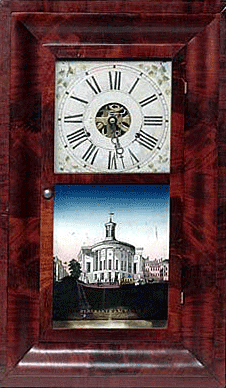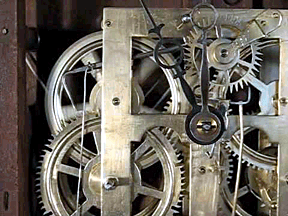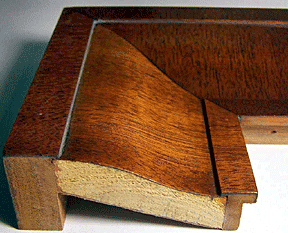|
 An
ogee clock is basically a pine box covered in veneer utilizing a
ogee curve in its case design giving it a unique style and its
name. The earliest examples were produced in 1840, and the style
continued through 1910 by almost every American maker as they
were simple and cheap to manufacture without needing a lot of
highly skilled labor. Typically, an ogee is a shelf clock, but
they're sometimes hung on the wall. Time and strike are standard
for these clocks. Additional features may include an alarm
mechanism or simple calendar, but these are normally found in
the later spring-driven models. An
ogee clock is basically a pine box covered in veneer utilizing a
ogee curve in its case design giving it a unique style and its
name. The earliest examples were produced in 1840, and the style
continued through 1910 by almost every American maker as they
were simple and cheap to manufacture without needing a lot of
highly skilled labor. Typically, an ogee is a shelf clock, but
they're sometimes hung on the wall. Time and strike are standard
for these clocks. Additional features may include an alarm
mechanism or simple calendar, but these are normally found in
the later spring-driven models.
The Case
Wooden molding with an ogee curve frames the front door of an
ogee clock. A clear glass panel on the top of the door protects
the dial and hands while a second glass panel underneath
protects the pendulum. Often, makers stenciled or reverse
painted the lower glass panel, and sometimes they used mirrors
as a suitable replacement if the original painted glass panel
had been broken or as a less expensive alternative. Be sure to
take care when cleaning the glass so as not to damage the
decorated surface.
The Dial
Makers normally punched the dial from a sheet of zinc, painted white
with printed numerals. The metal and paint expand at different
temperatures often resulting in chipping and flaking of the paint
over time. Most dials seen today have been retouched or are often
recovered with printed paper.
The Works
 A
weight drives the rolled brass clockworks for 30 hours or 1 week,
with later versions being spring driven. The weights hang from a
cable strung over a pulley located in the top of the case. The
wooden pulleys are often worn at their axle and may “groan” or creak
as the clock runs. Repair of this condition can prove difficult as
the axle is often underneath the veneer. Clockmakers covered the
pulleys with a leather patch or a wooden cover to allow access if
the cable jumped the pulley. Without some type of cover dust could
quickly contaminate the oil in the movement. Should the cable need
reseating on the pulley, a hook can be fashioned from a paper clip
to catch the cable, placing it over the pulley with the weight
removed. A
weight drives the rolled brass clockworks for 30 hours or 1 week,
with later versions being spring driven. The weights hang from a
cable strung over a pulley located in the top of the case. The
wooden pulleys are often worn at their axle and may “groan” or creak
as the clock runs. Repair of this condition can prove difficult as
the axle is often underneath the veneer. Clockmakers covered the
pulleys with a leather patch or a wooden cover to allow access if
the cable jumped the pulley. Without some type of cover dust could
quickly contaminate the oil in the movement. Should the cable need
reseating on the pulley, a hook can be fashioned from a paper clip
to catch the cable, placing it over the pulley with the weight
removed.
Care should be used when hanging the pendulum as the long suspension
leader it hangs from may become dislodged from its mounting. Simply
removing the dial and reattaching it will fix the problem.
Regulation is the same as with any pendulum clock---raising the
pendulum will make the clock run raster, lower for slower.
Setting the Time
To set the time on an ogee clock, move the minute hand clockwise
only. Most weight driven ogee clocks only strike the hours to
conserve the weight drop. Stop and let the strike completely finish
before advancing to the next strike. Should the hour strike and hour
hand not be in agreement, the hour hand can be slipped on its shaft
to agree with the hour strike. The two may come out of sync if the
clock is allowed too completely run down. Take care not to drag your
fingernail against the dial surface while setting.
Winding the Clock
A weight driven ogee clock should be wound using a crank while
spring driven versions are wound using a key. Wind the weight to the
upper position but leave about an inch clearance. Take care not to
bind the weight into the top of the clock as this may cause a
mechanical lock. Be aware that a worn or frayed cable may break.
Caring for an Ogee Clock
 Remember
that the clock can be rather top heavy when the weights are wound up
and that the center of gravity changes as the clock runs down. To
prevent tipping over when the door is opened, placing a coin
under each of the front corners will give the clock a slight
counter-tilt. Remember
that the clock can be rather top heavy when the weights are wound up
and that the center of gravity changes as the clock runs down. To
prevent tipping over when the door is opened, placing a coin
under each of the front corners will give the clock a slight
counter-tilt.
Take care when dusting an ogee clock to ensure the cloth doesn't
catch and rip the veneer. Under no circumstances should a ogee clock
case be refinished as the chemicals used will delaminate the veneer
from the underlying base wood.
It's best to move an ogee clock when it's rundown, then the weights
can be removed along with the pendulum and transported separately.
Some ogee weights have a grove cut into them to allow clearance
between the cable when fully wound.
< Back
to Clocks Page
Go to Grandfather Clocks > |
